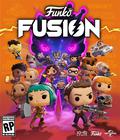Velocity 2X casts players as Lt. Kai Tana, the pilot of the prototype Quarp Jet. An accident teleports Kai Tana and her Quarp Jet to a galaxy that's run by the cruel Vokh, a tyrannical race of aliens who believe they have a divine right to rule the universe. They've created an armada by enslaving other races and seek to make humanity their next conquest. Kai Tana must free the enslaved races and use her Quarp Jet to stop the Vokh before they can discover its secrets and invade Earth.
Velocity 2X's plot is extremely barebones, but the biggest sin that the plot ends with a cliffhanger that obviously sets up the next game. The plot is told through brief cut scenes at the start of each stage, and they're automatically skipped upon any replay, but it's disappointing for the plot to be both simple and unfinished. There are some fun quotes and dialogue here and there, and it does its job well enough to provide some context to the gameplay.
You'll spend the bulk of your time in the shoot 'em up mode. You control the ship with the left analog stick, and you have two weapon types: bombs and lasers. Bombs can be aimed in any direction, and lasers are significantly stronger and faster but fire directly ahead. As with most shoot-'em-ups, you can find weapon power-ups by collecting upgrades in the levels, including a powerful upgraded laser or a tri-shot, although each only lasts a short time unless you collect recharge icons, which are dropped by enemies. You have unlimited lives, but if you die in the game, you're set back a short while — often less than half a screen. The only way to fail a stage is to let the time limit run out, but since most stages have time limits of 30 or more minutes, that's a rarity.
The most interesting feature of the game is the telepod. Your ship is equipped with a short-range teleporter that later upgrades into a long-range teleporter. There's no limit to how often you can teleport, and the only barrier to how far you can go is the screen size. A big chunk of the game involves using the teleporter to evade obstacles, collecting survivors scattered around the area, and getting into position to attack enemies. In long-range teleporting, the pod remains there. You can open a map to all of the teleport pods you've placed on a stage and teleport to any of them. One feature that is both positive and negative is that the game has a built-in warning that tells you when to drop a teleport pod. It would be pretty annoying if it didn't and you got stuck, but at the same time, you're going to use it when the screen flashes blue and rarely when it doesn't. Speedrunners may take advantage of the feature to cut seconds off their time, but anyone else will probably forget it exists when the screen isn't flashing.
The level design varies between stages. Some are more linear and straightforward while others are more complex mazes that use the telepod liberally. Your goal is simple: survive to the end while collecting enough items to meet your quota. The stages often feature energy generators that block off sections of the level and must be destroyed to advance. In linear stages, you must destroy these quickly to avoid having future areas blocked off. In the more maze-like stages, you have to destroy the generators in the correct order. Generators are all colored and numbered from 1 to 9, and you can only destroy a generator if it is the lowest-numbered surviving generator of that color. This can either block you off from optional pick-ups or prevent you from advancing. Another wrinkle is that not every generator is outside. Some are located inside space docks, which you'll have to enter on foot.
That brings us to the second of the two gameplay genres: 2-D platforming. Controlling Kai is smooth and easy. You have traditional run-and-gun mechanics of a platformer, but you actually have two kinds of guns: a palm cannon and rifle. The palm cannon can aim in any direction but is weaker and prevents you from running while using it. The rifle is stronger and faster but can only be aimed forward. Balancing the two for optimal speed is a big part of the platforming segments. You also have short- and long-range teleporting. The only twist is that you have to manually throw your telepod for long-range teleports. You can toss it through small gaps or bounce it off walls, but a particularly complex throw has specific markings to let you know where to toss it. Instead of survivors, you collect crystals while in the 2-D platforming segments, but otherwise, the structure is pretty much the same: run around and shoot generators to unlock new sections.
Of the two genres, I preferred the 2-D platforming. It's simplistic but fast-paced, and it's very smooth to play. Most of the teleport mazes boil down to dropping a teleport pod when the game tells you to and teleporting back when the icon flashes. In comparison, the 2-D segments feel like more is going on. You're constantly running, shooting, sliding, teleporting and on the move. The teleport controls feel better integrated, and the levels are more fun to explore. There is a noticeable lack of enemy variety, though. Aside from a few meaningless flying foes and automated turrets, the only real foes are shielded guards, who you defeat by teleporting through them to disable their shield and then shooting them. The only difference between early-game guards and end-game guards is they take more shots to defeat. A little more variety in enemy types would've helped a lot.
You won't die when you crash into a wall or are shot only once. Your ship is pretty durable and can be destroyed by repeated blows or if you're crushed by the bottom of the scrolling screen. The challenge revolves around being fast enough with your dodging and teleporting to avoid being crushed by the screen. It's very engaging, especially on the fast-paced levels, where frequent teleports are necessary to grab every item and escape. The shoot-'em-up stages feel repetitive faster than the platforming sequences due to the lack of variety. The high point of the shoot-'em-up segments is the boss fights, which tend to be a fun combination of all the game mechanics.
The game levels are divided into three types, although they are pretty similar. One focuses on speed and often has little to nothing in the way of teleport puzzles. One is about defeating enemies and is a solid mix of fast-paced sequences and teleporting. The last, Search and Rescue, tends to be the slowest of the three and far more focused on exploring mazes with complex configurations of energy barriers. Each has its own strengths and weaknesses. The Search and Rescue missions are fun on the first playthrough but easily the worst of the three to replay. Once you've solved the puzzles, they're significantly longer and less fun than the other two types. All three types involve swapping between the two genres. You'll switch over to platforming every time you land at a space dock and swap back out once you leave the dock. It's generally very clear when you need to swap in and out.
Unfortunately, the method of unlocking levels is poorly implemented. You unlock levels by getting a certain cumulative score on the previous levels. For a huge chunk of the game, this is a complete nonentity and you'll probably be five levels ahead of where you need to be. For the last four levels, you're likely to run into a point where you need to go back and replay a previous level to boost your score. It isn't too painful since you retain all your upgrades and abilities. Additionally, the unlock requirements for each level are tallied by your highest overall ranking individual category which makes it very easy to boost your speed score by replaying a few early levels where you had a slow time. It's not a tremendous problem, but it throws a bit of a bucket of cold water on the game.
Also frustrating are those last few levels. They implement a new gimmick that is both interesting and frustrating. It's difficult to define it clearly without going into story spoilers, but it involves a drastic change to the way you play the game. It's actually a cool idea, but it's awkward to control, and it's pretty clear that the gimmick doesn't have much of a shelf life, but from the moment you get it, it simply dominates the game. Particularly frustrating is that, due to this gimmick, the last boss fight is resolved entirely via cut scene, which is a remarkably unsatisfying way to handle an encounter that has been built up for the entirety of the game. The ending doesn't do the game any favors, either.
Still, those problems are minor in the grand scheme of things. Velocity 2X does a great job of keeping the gameplay interesting and engaging. It comes close to overstaying its welcome but never actually does. There are 50 total levels in addition to a number of bonus levels you can unlock by finding hidden crystals scattered throughout the stages. There are also a number of collectible items that reveal more about the races and characters in the game, although none are particularly essential. There's a lot of value here, and the difficulty of getting a Perfect score on every stage or taking on leaderboards is certain to add extra playtime to the game.
Velocity 2X is a nice, if simplistic-looking, game. The models are unmemorable, and the environments are pretty dull, but the core art design is strong, and everything is instantly identifiable. The still artwork in the cut scenes varies in quality but tells the story well enough. The game runs at a smooth pace with no noticeable slowdowns or hiccups. The soundtrack is easily the standout, featuring a lot of fast-paced, techno-style music that sets the tone for the game. A little more variety in the music would have been nice, but it never overstayed its welcome.
Velocity 2X is a solid and well-made blend of shoot-'em-up and platforming action. It doesn't quite touch the best of either genre, but the mix of the two styles and the teleport-themed puzzles help give the title its own identity. The improvements over the original Velocity are noticeable, and the game is fun to play. It keeps up a fast pace, although it gets somewhat repetitive toward the end. A few nagging flaws and problems hold it back, but they're nothing more than slight blemishes on a very enjoyable game.
Score: 8.0/10
More articles about Velocity 2X











 Weaving together two classic game formats into one seamless experience, Velocity 2X features puzzle-platforming action alongside the award-winning top-down shoot-'em-up gameplay.
Weaving together two classic game formats into one seamless experience, Velocity 2X features puzzle-platforming action alongside the award-winning top-down shoot-'em-up gameplay.





































